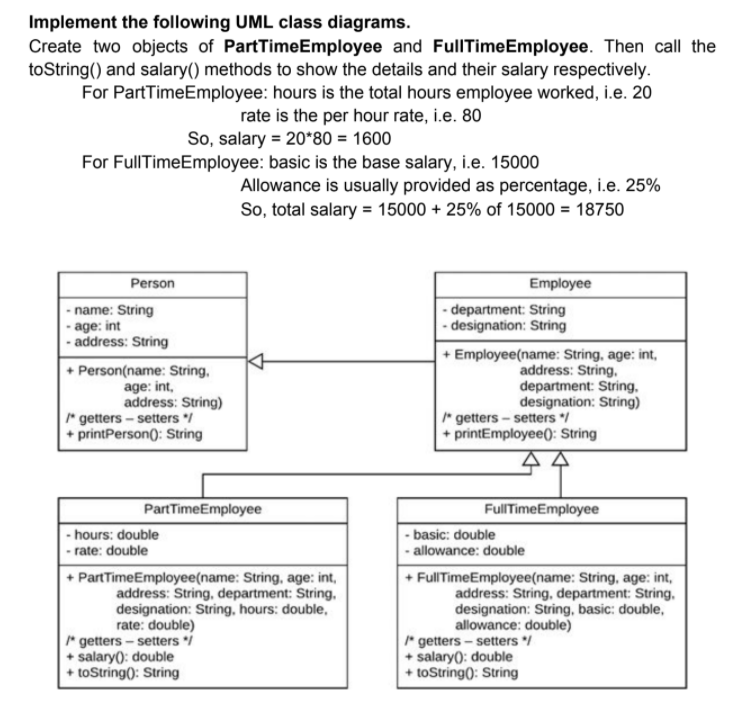Person Employee - name: String age: int address: String - department: String designation: String + Person(name: String, age: int, address: String) r getters - setters / + printPerson(: String + Employee(name: String, age: int, address: String, department: String, designation: String) * getters - setters / + printEmployee0: String PartTimeEmployee FullTimeEmployee - basic: double - allowance: double - hours: double - rate: double + PartTimeEmployee(name: String, age: int, address: String, department: String, designation: String, hours: double, rate: double) * getters - setters / + salary): double + toString(): String + FullTimeEmployee(name: String, age: int, address: String, department: String, designation: String, basic: double, allowance: double) * getters - setters / + salary): double + toString(): String
Person Employee - name: String age: int address: String - department: String designation: String + Person(name: String, age: int, address: String) r getters - setters / + printPerson(: String + Employee(name: String, age: int, address: String, department: String, designation: String) * getters - setters / + printEmployee0: String PartTimeEmployee FullTimeEmployee - basic: double - allowance: double - hours: double - rate: double + PartTimeEmployee(name: String, age: int, address: String, department: String, designation: String, hours: double, rate: double) * getters - setters / + salary): double + toString(): String + FullTimeEmployee(name: String, age: int, address: String, department: String, designation: String, basic: double, allowance: double) * getters - setters / + salary): double + toString(): String
Database System Concepts
7th Edition
ISBN:9780078022159
Author:Abraham Silberschatz Professor, Henry F. Korth, S. Sudarshan
Publisher:Abraham Silberschatz Professor, Henry F. Korth, S. Sudarshan
Chapter1: Introduction
Section: Chapter Questions
Problem 1PE
Related questions
Question

Transcribed Image Text:Implement the following UML class diagrams.
Create two objects of PartTimeEmployee and FullITimeEmployee. Then call the
toString() and salary() methods to show the details and their salary respectively.
For PartTimeEmployee: hours is the total hours employee worked, i.e. 20
rate is the per hour rate, i.e. 80
So, salary = 20*80 = 1600
For FullTimeEmployee: basic is the base salary, i.e. 15000
Allowance is usually provided as percentage, i.e. 25%
So, total salary = 15000 + 25% of 15000 = 18750
Person
Employee
- name: String
- age: int
- address: String
- department: String
- designation: String
+ Person(name: String,
age: int,
address: String)
* getters - setters /
+ printPerson(: String
+ Employee(name: String, age: int,
address: String,
department: String,
designation: String)
* getters - setters /
+ printEmployee): String
PartTimeEmployee
FulITimeEmployee
- basic: double
- allowance: double
- hours: double
- rate: double
+ PartTimeEmployee(name: String, age: int,
address: String, department: String,
designation: String, hours: double,
rate: double)
* getters - setters i
+ salary): double
+ toString(): String
+ FullTimeEmployee(name: String, age: int,
address: String, department: String.
designation: String, basic: double,
allowance: double)
* getters - setters /
+ salary(): double
+ toString(): String
Expert Solution
This question has been solved!
Explore an expertly crafted, step-by-step solution for a thorough understanding of key concepts.
This is a popular solution!
Trending now
This is a popular solution!
Step by step
Solved in 3 steps with 1 images

Knowledge Booster
Learn more about
Need a deep-dive on the concept behind this application? Look no further. Learn more about this topic, computer-science and related others by exploring similar questions and additional content below.Recommended textbooks for you

Database System Concepts
Computer Science
ISBN:
9780078022159
Author:
Abraham Silberschatz Professor, Henry F. Korth, S. Sudarshan
Publisher:
McGraw-Hill Education

Starting Out with Python (4th Edition)
Computer Science
ISBN:
9780134444321
Author:
Tony Gaddis
Publisher:
PEARSON

Digital Fundamentals (11th Edition)
Computer Science
ISBN:
9780132737968
Author:
Thomas L. Floyd
Publisher:
PEARSON

Database System Concepts
Computer Science
ISBN:
9780078022159
Author:
Abraham Silberschatz Professor, Henry F. Korth, S. Sudarshan
Publisher:
McGraw-Hill Education

Starting Out with Python (4th Edition)
Computer Science
ISBN:
9780134444321
Author:
Tony Gaddis
Publisher:
PEARSON

Digital Fundamentals (11th Edition)
Computer Science
ISBN:
9780132737968
Author:
Thomas L. Floyd
Publisher:
PEARSON

C How to Program (8th Edition)
Computer Science
ISBN:
9780133976892
Author:
Paul J. Deitel, Harvey Deitel
Publisher:
PEARSON

Database Systems: Design, Implementation, & Manag…
Computer Science
ISBN:
9781337627900
Author:
Carlos Coronel, Steven Morris
Publisher:
Cengage Learning

Programmable Logic Controllers
Computer Science
ISBN:
9780073373843
Author:
Frank D. Petruzella
Publisher:
McGraw-Hill Education